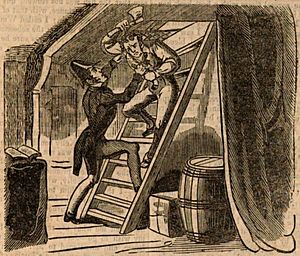Edward Jordan (pirate) facts for kids
Edward Jordan (1771–1809) was an Irish rebel, fisherman, and pirate in Nova Scotia. He was one of the pirates who appeared after the main "Golden Age of Piracy" had ended in the 18th century. Born in County Carlow, Ireland, he took part in the Irish rebellions of 1797–1798. After these events, he received a pardon and tried to start a new life as a fisherman in Nova Scotia.
Contents
Edward Jordan: A Pirate's Story
Early Life and New Beginnings
Edward Jordan was born in County Carlow, Ireland, in 1771. As a young man, he became involved in the Irish rebellions that took place in 1797 and 1798. These were times of great change and conflict in Ireland. After the rebellion, Jordan was given a pardon, which meant he was forgiven for his actions. He decided to leave Ireland and seek a fresh start in Nova Scotia, hoping to build a peaceful life as a fisherman.
Fishing Troubles in Nova Scotia
Jordan set up his fishing business at Gaspe Bay. However, his seasonal fishing operation did not go well. He struggled to make enough money and soon found himself in serious debt. Merchants in Halifax, a major city in Nova Scotia, decided to take his fishing schooner, The Three Sisters, to cover the money he owed them.
A Desperate Act
On September 13, 1809, Edward Jordan was desperate to keep his schooner. He tried to stop the crew sent to take his ship. During the struggle, he attacked them. Two sailors were killed. However, the captain, John Stairs, was only hurt. Captain Stairs managed to escape by jumping overboard. He was rescued by another fishing schooner passing by. Captain Stairs then spread the word about what had happened.
Capture and Consequences
A few weeks after the attack, the Royal Navy schooner HMS Cuttle captured Edward Jordan. He was taken to Halifax, Nova Scotia, where he was found guilty of piracy. Piracy was a very serious crime at that time.
After his conviction, Jordan was executed in Halifax. His body was covered in tar and placed in an iron cage called a gibbet. This gibbet was then hung from chains at Black Rock Beach in Point Pleasant. This was done as a public warning to others. His gibbet was near those of four other men. These men had been executed for a rebellion on their ship, the brig HMS Columbine, in the same year.
Years later, Edward Jordan's skull was given to the Nova Scotia Museum. It was recently shown in a special exhibit called "Pirates: Myth and Reality" at the Maritime Museum of the Atlantic in Halifax. This exhibit helped people learn more about the real lives of pirates.


